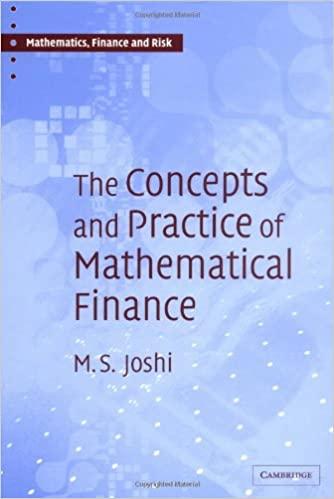Question
The RBC case describes two methods for computing the lifetime value of a customer. One method (Markov Chain and Transition matrices) takes into account the
The RBC case describes two methods for computing the lifetime value of a customer. One method (Markov Chain and Transition matrices) takes into account the expected likelihood that a customer holding a particular product portfolio will migrate to another portfolio or leave the bank in the future.
Assume that RBC has only two products: Car Loan (CL) and Credit Card (CC). The annual profitability for each of the two products is (-$100) (i.e., $100 loss) for CL and +$1000 for CC.
RBC has made the following observation for customers in the 25-30 year segment:
- If they have a car loan at the end of a given year, the probability of also acquiring a credit card during the following year is 50%
- The probability of losing even this one product during the following year is 20%
- The probability that the customer retains only the car loan during the following year is 20%
- The probability that the customer drops the car loan but acquires a credit card during the following year is 10%
Similar observations can be made for individuals who begin the year with only a credit card, both products, or neither product. These observations are summarized in the following matrix of probabilities.
Probabilities for year t+1 product mix for all possible combinations of product mixes for year t.
|
|
| Product mix in year t+1 | ||||||
| Product mix in year t |
| CL |
| CC |
| CL+CC |
| None |
| CL |
| 0.2 |
| 0.1 |
| 0.5 |
| 0.2 |
| CC |
| 0.1 |
| 0.5 |
| 0.2 |
| 0.2 |
| CL+CC |
| 0.1 |
| 0.1 |
| 0.7 |
| 0.1 |
| None |
| 0 |
| 0 |
| 0 |
| 1 |
Answer the following questions using a 8% discount rate:
- Consider a customer who has only a credit card in year t. What is
- The expected profit generated by this customer in year t+1?
- The present value of expected profits from this customer for both years combined?
- Consider a customer who has both a car loan and credit card in time t. What is
- The expected profit generated by this customer in year t+1?
- The present value of expected profits from this customer for both years combined?
- Discuss how these results will be useful for you to design a market strategy. Be specific in your suggestions and provide concrete suggestions.
Step by Step Solution
There are 3 Steps involved in it
Step: 1

Get Instant Access to Expert-Tailored Solutions
See step-by-step solutions with expert insights and AI powered tools for academic success
Step: 2

Step: 3

Ace Your Homework with AI
Get the answers you need in no time with our AI-driven, step-by-step assistance
Get Started


